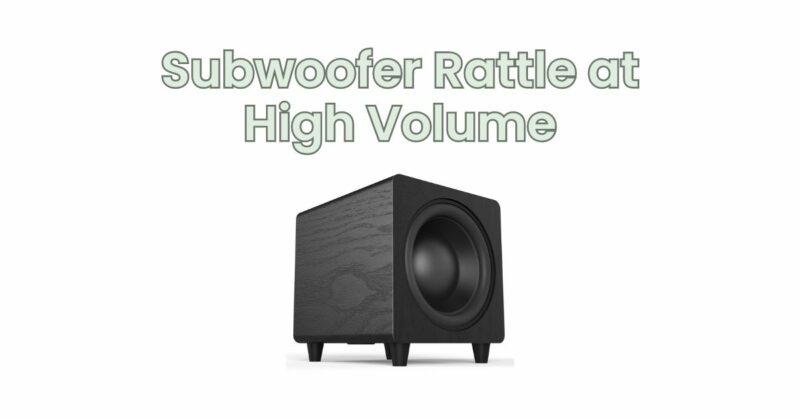If you’re experiencing a rattling sound coming from your subwoofer when playing music at high volume levels, it can be quite frustrating. Subwoofer rattle can diminish the overall audio quality and affect your listening experience. In this article, we will explore the common causes of subwoofer rattle at high volume and provide you with some solutions to address the issue effectively.
- Loose or Damaged Enclosure: A common cause of subwoofer rattle is a loose or damaged enclosure. The vibrations produced by the powerful bass frequencies can cause panels, screws, or internal bracing to become loose over time. Inspect the subwoofer enclosure for any loose components and tighten them securely. If the enclosure is damaged, consider repairing or replacing it to ensure proper structural integrity.
- Inadequate Sound Damping: Insufficient sound damping within the enclosure can contribute to rattling sounds. The vibrations generated by the subwoofer can resonate with the enclosure panels, causing them to rattle. Consider adding additional sound damping materials such as acoustic foam, damping mats, or polyfill inside the enclosure. These materials help absorb vibrations and reduce rattling.
- Loose or Misaligned Subwoofer Driver: Check the subwoofer driver itself to ensure it is securely mounted within the enclosure. A loose or misaligned subwoofer driver can cause rattling at high volumes. Make sure the driver is properly fastened to the enclosure using the designated mounting screws or brackets. Align the driver correctly with the opening to prevent any interference or contact with the enclosure.
- Overexcursion or Bottoming Out: Overexcursion occurs when the subwoofer cone moves beyond its designed limits, causing it to hit the enclosure or internal components. This can lead to rattling sounds. Adjust the subwoofer’s settings, such as reducing the gain or applying a high-pass filter, to prevent overexcursion and protect the subwoofer from bottoming out. Find the optimal balance between volume and preventing excessive cone movement.
- Voice Coil Damage: A damaged voice coil can cause irregular movements of the subwoofer cone, leading to rattling sounds. If the voice coil is damaged, it may need to be repaired or replaced by a professional. Inspect the subwoofer for any signs of damage, such as burnt or distorted voice coil. If you suspect voice coil damage, it’s best to consult a qualified technician for further evaluation and repair.
- Amplifier Distortion or Clipping: If the amplifier driving the subwoofer is experiencing distortion or clipping, it can result in rattling sounds. Distorted signals can cause the subwoofer to produce unwanted harmonics and overdrive the driver, leading to rattling. Ensure that the amplifier is properly matched to the subwoofer’s power requirements and that it is not being pushed beyond its limits. Adjust the amplifier settings and gain levels to prevent distortion and clipping.
- Seek Professional Assistance: If the rattling sound persists despite your troubleshooting efforts, it is advisable to seek professional assistance. A knowledgeable audio technician can diagnose the issue more accurately and provide appropriate solutions. They may conduct advanced tests, such as impedance measurements or driver inspection, to identify the root cause of the rattling and suggest the best course of action.
Subwoofer rattle at high volume can be a nuisance, but it is a common issue that can be addressed effectively. By checking the enclosure, ensuring proper sound damping, securing the subwoofer driver, preventing overexcursion, and addressing amplifier-related concerns, you can significantly reduce or eliminate rattling sounds. If troubleshooting steps don’t resolve the issue, consulting a professional will help you diagnose and rectify the problem. Enjoy clean and distortion-free bass by taking the necessary steps to eliminate subwoofer rattling at high volume.


